The Calorimeters Market is estimated to be valued at USD 21.7 billion in 2025 and is projected to reach USD 30.3 billion by 2035, registering a compound annual growth rate (CAGR) of 3.4% over the forecast period.
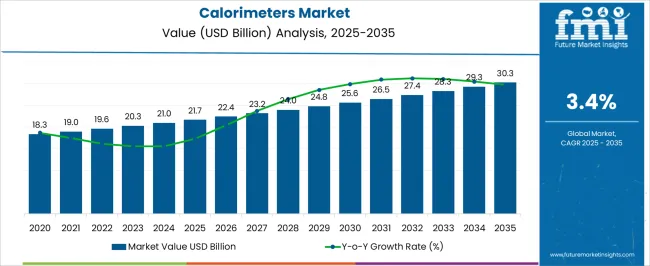
| Metric | Value |
|---|---|
| Calorimeters Market Estimated Value in (2025 E) | USD 21.7 billion |
| Calorimeters Market Forecast Value in (2035 F) | USD 30.3 billion |
| Forecast CAGR (2025 to 2035) | 3.4% |
The Calorimeters market is being driven by increasing demand across scientific research, industrial testing, and healthcare applications. In 2025, the market is witnessing steady expansion as more organizations prioritize accurate thermal measurement and energy analysis in product development, process optimization, and biochemical research. Growing investments in laboratories, research facilities, and industrial testing units are supporting the adoption of advanced calorimetry techniques.
The need for improved energy efficiency, sustainable manufacturing, and precision analytics is contributing to the rising utilization of calorimeters in both public and private sectors. Furthermore, technological advancements in sensor integration, data acquisition systems, and automation have enhanced the usability and accuracy of calorimeters, making them more accessible to a wider range of users.
Increasing collaborations between academic institutions and industry players are creating pathways for more customized solutions, while regulatory frameworks promoting energy monitoring and process validation further reinforce demand The outlook remains positive as industries focus on innovation, sustainability, and research-driven outcomes where calorimetry plays a vital role in thermal analysis.
The calorimeters market is segmented by type, industry, and geographic regions. By type, calorimeters market is divided into Bomb Calorimeters, Adiabatic Calorimeters, Reaction Calorimeters, Combustion Of Non-Flammables, Calvet-Type Calorimeters, Constant-Pressure Calorimeter, Differential Scanning Calorimeter, and Isothermal Titration Calorimeter. In terms of industry, calorimeters market is classified into Biochemistry, Power Industry, Coal & Petrochemical, and Others. Regionally, the calorimeters industry is classified into North America, Latin America, Western Europe, Eastern Europe, Balkan & Baltic Countries, Russia & Belarus, Central Asia, East Asia, South Asia & Pacific, and the Middle East & Africa.
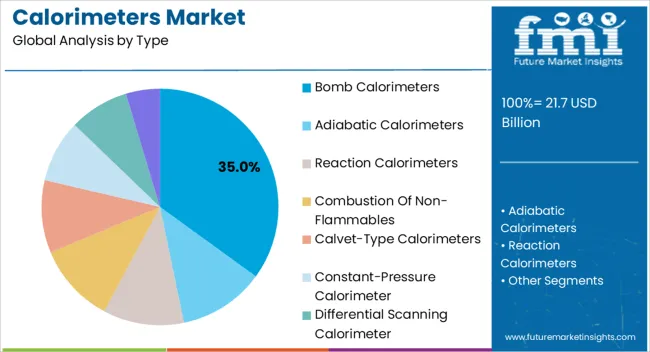
The Bomb Calorimeters segment is expected to hold 35.00% of the Calorimeters market revenue share in 2025, making it the leading type in the market. This position is being attributed to its high accuracy and reliability in measuring heat of combustion, which is essential for applications in fuel testing, food science, and material analysis.
The adoption of bomb calorimeters has been supported by industries requiring precise energy data to improve product formulation and performance evaluation. Its robustness and ability to deliver consistent results under controlled conditions have made it preferable for laboratory and industrial settings where precision is critical.
Furthermore, increasing emphasis on environmental sustainability and energy efficiency has fueled the demand for reliable energy measurement tools, which bomb calorimeters are well-suited to provide The segment’s continued growth is being driven by research initiatives aimed at optimizing combustion processes and improving material energy profiles, where the use of bomb calorimeters plays a crucial role in ensuring accurate data collection and process validation.
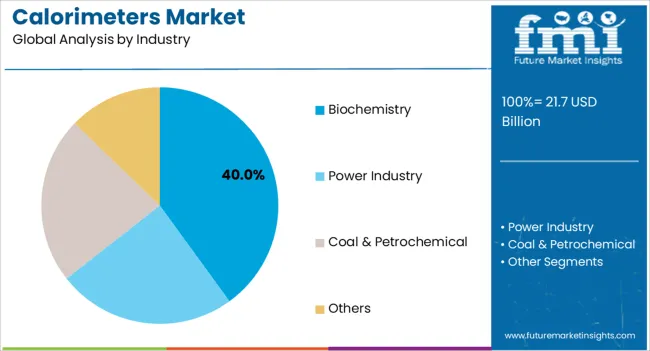
The Biochemistry industry segment is anticipated to account for 40.00% of the Calorimeters market revenue share in 2025, emerging as the largest end-use sector. This leadership has been driven by the rising need for calorimetry in research focused on metabolic analysis, enzyme kinetics, and molecular interactions. In biochemical laboratories, calorimeters are widely employed to study heat changes associated with chemical reactions, protein folding, and binding events, providing vital insights into biological processes.
The increasing prevalence of research aimed at understanding cellular functions, disease mechanisms, and drug interactions has further accelerated the integration of calorimetry techniques in biochemistry workflows. Additionally, the development of specialized calorimeters designed for small sample volumes and sensitive measurements has supported broader adoption in laboratory environments.
The segment’s growth is being enhanced by rising investments in life sciences research and growing demand for data-driven analysis tools that support breakthroughs in drug discovery and personalized medicine As research continues to evolve toward more complex biological systems, calorimeters are expected to remain a core analytical instrument in the biochemistry sector.
Calorimeters are devices used in calorimetry to measure the heat absorbed or given out during chemical reactions and the overall heat capacity of materials under study. Most common calorimeters types used today are accelerating rate calorimeters, isothermal titration calorimeter etc.
A simple calorimeter features a thermometer that is attached to a metal container filled with water. The thermometer is suspended above a chemical combustion chamber. Calorimeters are frequently used in analysis, processing and research fields and find common applications in biochemistry, thermodynamics and chemistry domains.
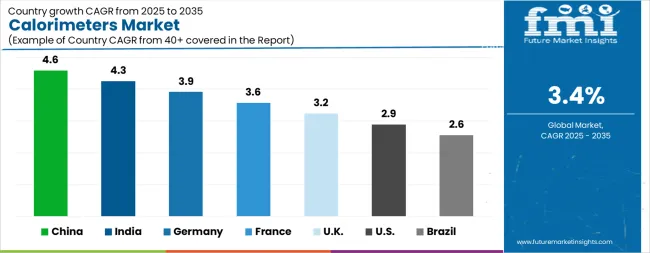
| Country | CAGR |
|---|---|
| China | 4.6% |
| India | 4.3% |
| Germany | 3.9% |
| France | 3.6% |
| UK | 3.2% |
| USA | 2.9% |
| Brazil | 2.6% |
The Calorimeters Market is expected to register a CAGR of 3.4% during the forecast period, exhibiting varied country level momentum. China leads with the highest CAGR of 4.6%, followed by India at 4.3%. Developed markets such as Germany, France, and the UK continue to expand steadily, while the USA is likely to grow at consistent rates. Brazil posts the lowest CAGR at 2.6%, yet still underscores a broadly positive trajectory for the global Calorimeters Market. In 2024, Germany held a dominant revenue in the Western Europe market and is expected to grow with a CAGR of 3.9%. The USACalorimeters Market is estimated to be valued at USD 8.1 billion in 2025 and is anticipated to reach a valuation of USD 10.8 billion by 2035. Sales are projected to rise at a CAGR of 2.9% over the forecast period between 2025 and 2035. While Japan and South Korea markets are estimated to be valued at USD 1.2 billion and USD 726.9 million respectively in 2025.
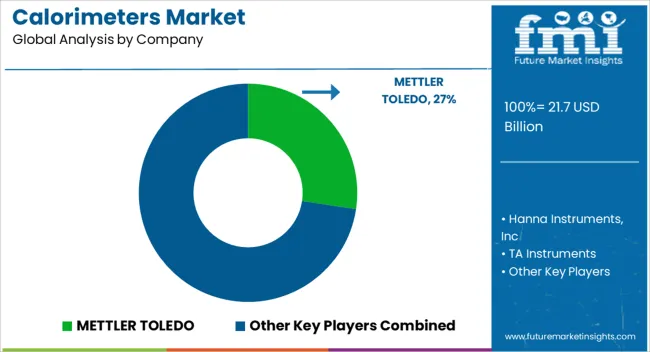
| Item | Value |
|---|---|
| Quantitative Units | USD 21.7 Billion |
| Type | Bomb Calorimeters, Adiabatic Calorimeters, Reaction Calorimeters, Combustion Of Non-Flammables, Calvet-Type Calorimeters, Constant-Pressure Calorimeter, Differential Scanning Calorimeter, and Isothermal Titration Calorimeter |
| Industry | Biochemistry, Power Industry, Coal & Petrochemical, and Others |
| Regions Covered | North America, Europe, Asia-Pacific, Latin America, Middle East & Africa |
| Country Covered | United States, Canada, Germany, France, United Kingdom, China, Japan, India, Brazil, South Africa |
| Key Companies Profiled | METTLER TOLEDO, Hanna Instruments, Inc, TA Instruments, Shimadzu Corporation, Setaram Instrumentation, Parr Instrument Company, NETZSCH Instruments, Inc, Yokogawa Electric Corporation, ABB, Malvern Panalytical Ltd, Swan Analytische Instrumente AG, Columbus Instruments, and COSMED |
The global calorimeters market is estimated to be valued at USD 21.7 billion in 2025.
The market size for the calorimeters market is projected to reach USD 30.3 billion by 2035.
The calorimeters market is expected to grow at a 3.4% CAGR between 2025 and 2035.
The key product types in calorimeters market are bomb calorimeters, adiabatic calorimeters, reaction calorimeters, combustion of non-flammables, calvet-type calorimeters, constant-pressure calorimeter, differential scanning calorimeter and isothermal titration calorimeter.
In terms of industry, biochemistry segment to command 40.0% share in the calorimeters market in 2025.






Our Research Products

The "Full Research Suite" delivers actionable market intel, deep dives on markets or technologies, so clients act faster, cut risk, and unlock growth.

The Leaderboard benchmarks and ranks top vendors, classifying them as Established Leaders, Leading Challengers, or Disruptors & Challengers.

Locates where complements amplify value and substitutes erode it, forecasting net impact by horizon

We deliver granular, decision-grade intel: market sizing, 5-year forecasts, pricing, adoption, usage, revenue, and operational KPIs—plus competitor tracking, regulation, and value chains—across 60 countries broadly.

Spot the shifts before they hit your P&L. We track inflection points, adoption curves, pricing moves, and ecosystem plays to show where demand is heading, why it is changing, and what to do next across high-growth markets and disruptive tech

Real-time reads of user behavior. We track shifting priorities, perceptions of today’s and next-gen services, and provider experience, then pace how fast tech moves from trial to adoption, blending buyer, consumer, and channel inputs with social signals (#WhySwitch, #UX).

Partner with our analyst team to build a custom report designed around your business priorities. From analysing market trends to assessing competitors or crafting bespoke datasets, we tailor insights to your needs.
Supplier Intelligence
Discovery & Profiling
Capacity & Footprint
Performance & Risk
Compliance & Governance
Commercial Readiness
Who Supplies Whom
Scorecards & Shortlists
Playbooks & Docs
Category Intelligence
Definition & Scope
Demand & Use Cases
Cost Drivers
Market Structure
Supply Chain Map
Trade & Policy
Operating Norms
Deliverables
Buyer Intelligence
Account Basics
Spend & Scope
Procurement Model
Vendor Requirements
Terms & Policies
Entry Strategy
Pain Points & Triggers
Outputs
Pricing Analysis
Benchmarks
Trends
Should-Cost
Indexation
Landed Cost
Commercial Terms
Deliverables
Brand Analysis
Positioning & Value Prop
Share & Presence
Customer Evidence
Go-to-Market
Digital & Reputation
Compliance & Trust
KPIs & Gaps
Outputs
Full Research Suite comprises of:
Market outlook & trends analysis
Interviews & case studies
Strategic recommendations
Vendor profiles & capabilities analysis
5-year forecasts
8 regions and 60+ country-level data splits
Market segment data splits
12 months of continuous data updates
DELIVERED AS:
PDF EXCEL ONLINE

Thank you!
You will receive an email from our Business Development Manager. Please be sure to check your SPAM/JUNK folder too.
Chat With
MaRIA